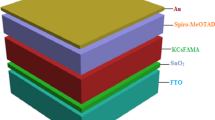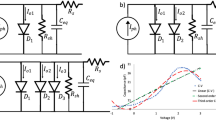Abstract
Hybrid perovskite solar cell technology has a distinct advantage over the conventional solar cell technologies due to its high predicted efficiency and low manufacturing cost. However, its commercialization is hindered by the unpredictability existing in its J-V characteristics leading to ambiguous efficiency estimation. Modeling the hysteresis in the J-V characteristics is a means of curtailing this ambiguity. It is established in literature that hysteresis models can be derived from the non-linear behavior of ferroelectric materials. Perovskite, which forms the light absorbing region of the solar cell is a ferroelectric material. In this paper, an equivalent circuit model for the hybrid perovskite solar cell is proposed in which the reasons for origin of hysteresis is characterized as varying capacitance to model hysteresis. A Landau–Khalatnikov subcircuit which portrays this variation is the principal addition to the conventional model to include hysteresis effect. The model parameters of the subcircuit are estimated from the inherent properties of perovskites. Hence, the proposed equivalent circuit model is completely physics based and it links the material property of perovskite to its equivalent circuit model parameters.











Similar content being viewed by others
Data availability
Data sharing not applicable to this article as no datasets were generated or analysed during the current study.
References
Agarwal, S., Seetharaman, M., Kumawat, N.K., Subbiah, A.S., Sarkar, S.K., Kabra, D., Nair, P.R.: On the uniqueness of ideality factor and voltage exponent of perovskite-based solar cells. J. Phys. Chem. Lett. 5(23), 4115–4121 (2014). https://doi.org/10.1021/jz5021636
Anghel, D.V., Nemnes, G.A., Pintilie, I., Manolescu, A.: Modelling J-V hysteresis in perovskite solar cells induced by voltage poling. Phys. Scripta 94(12), 125809 (2019). https://doi.org/10.1088/1402-4896/ab347d
Azpiroz, J.M., Mosconi, E., Bisquert, J., De Angelis, F.: Defect migration in methylammonium lead iodide and its role in perovskite solar cell operation. Energy Environ. Sci. 8(7), 2118–2127 (2015). https://doi.org/10.1039/C5EE01265A
Bisquert, J.: Chemical capacitance of nanostructured semiconductors: its origin and significance for nanocomposite solar cells. Phys. Chem. Chem. Phys. 5(24), 5360–5364 (2003). https://doi.org/10.1039/B310907K
Bisquert, J., Guerrero, A.: Chemical Inductor. J. Am. Chem. Soc. 144(13), 5996–6009 (2022). https://doi.org/10.1021/jacs.2c00777
Bisquert, J., Guerrero, A., Gonzales, C.: Theory of hysteresis in halide perovskites by integration of the equivalent circuit. ACS Phys. Chem. Au 1(1), 25–44 (2021). https://doi.org/10.1021/acsphyschemau.1c00009
Chen, B., Yang, M., Priya, S., Zhu, K.: Origin of J-V hysteresis in perovskite solar cells. J. Phys. Chem. Lett. 7(5), 905–917 (2016). https://doi.org/10.1021/acs.jpclett.6b00215
Cojocaru, L., Uchida, S., Jayaweera, P.V., Kaneko, S., Nakazaki, J., Kubo, T., Segawa, H.: Origin of the hysteresis in I-V curves for planar structure perovskite solar cells rationalized with a surface boundary-induced capacitance model. Chem. Lett. 44(12), 1750–1752 (2015). https://doi.org/10.1246/cl.150933
Cojocaru, L., Uchida, S., Jayaweera, P.V., Kaneko, S., Toyoshima, Y., Nakazaki, J., Segawa, H.: Simulation of current-voltage curves for inverted planar structure perovskite solar cells using equivalent circuit model with inductance. Appl. Phys. Expr. 10(2), 025701 (2017). https://doi.org/10.7567/APEX.10.025701
Cubas, J., Pindado, S., De Manuel, C.: Explicit expressions for solar panel equivalent circuit parameters based on analytical formulation and the Lambert W-function. Energies 7(7), 4098–4115 (2014). https://doi.org/10.3390/en7074098
Dragan, D., Mayergoyz, I., Bertotti, G.: The science of hysteresis, p. 337. Elsevier, Amsterdam (2005)
Eames, C., Frost, J.M., Barnes, P.R., O’regan, B.C., Walsh, A., Islam, M.S.: Ionic transport in hybrid lead iodide perovskite solar cells. Nature Commun. 6(1), 1–8 (2015). https://doi.org/10.1038/ncomms8497
Ebadi, F., Taghavinia, N., Mohammadpour, R., Hagfeldt, A., Tress, W.: Origin of apparent light-enhanced and negative capacitance in perovskite solar cells. Nature Commun. 10(1), 1–9 (2019). https://doi.org/10.1038/s41467-019-09079-z
Elumalai, N.K., Uddin, A.: Hysteresis in organic-inorganic hybrid perovskite solar cells. Solar Energy Mater. Solar Cells 157, 476–509 (2016). https://doi.org/10.1016/j.solmat.2016.06.025
Elumalai, N.K., Mahmud, M.A., Wang, D., Uddin, A.: Perovskite solar cells: progress and advancements. Energies 9(11), 861 (2016). https://doi.org/10.3390/en9110861
Frost, J.M., Butler, K.T., Walsh, A.: Molecular ferroelectric contributions to anomalous hysteresis in hybrid perovskite solar cells. Apl Mater. 2(8), 081506 (2014). https://doi.org/10.1063/1.4890246
Guerrero, A., Bisquert, J., Garcia-Belmonte, G.: Impedance spectroscopy of metal halide perovskite solar cells from the perspective of equivalent circuits. Chem. Rev. 121(23), 14430–14484 (2021). https://doi.org/10.1021/acs.chemrev.1c00214
Íñiguez, J., Zubko, P., Luk’yanchuk, I., Cano, A.: Ferroelectric negative capacitance. Nature Rev. Mater. 4(4), 243–256 (2019). https://doi.org/10.1038/s41578-019-0089-0
Jeong, J., Kim, M., Seo, J., Lu, H., Ahlawat, P., Mishra, A., Kim, J.Y.: Pseudo-halide anion engineering for \(\alpha -\text{ FAPbI}_{3}\) perovskite solar cells. Nature 592(7854), 381–385 (2021). https://doi.org/10.1038/s41586-021-03406-5
Kalyanasundaram, K., Zakeeruddin, S., Grätzel, M.: Recent advances in hybrid halide perovskites-based solar cells. Mater. Matters 11(1), 3–10 (2016)
Khan, A.I., Chatterjee, K., Wang, B., Drapcho, S., You, L., Serrao, C., Salahuddin, S.: Negative capacitance in a ferroelectric capacitor. Nature Mater. 14(2), 182–186 (2015). https://doi.org/10.1038/nmat4148
Kim, H.S., Jang, I.H., Ahn, N., Choi, M., Guerrero, A., Bisquert, J., Park, N.G.: Control of I-V hysteresis in CH3NH3PbI3 perovskite solar cell. J. Phys. Chem. Lett. 6(22), 4633–4639 (2015). https://doi.org/10.1021/acs.jpclett.5b02273
Kittel, C., McEuen, P., McEuen, P.: Introduction to solid state physics. Wiley, New York (1996)
Kojima, A., Teshima, K., Shirai, Y., Miyasaka, T.: Organometal halide perovskites as visible-light sensitizers for photovoltaic cells. J. Am. Chem. Soc. 131(17), 6050–6051 (2009). https://doi.org/10.1021/ja809598r
Kumar, A.: Numerical modelling of ion-migration caused hysteresis in perovskite solar cells. Opt. Quantum Electron. 53(4), 1–9 (2021). https://doi.org/10.1007/s11082-021-02806-1
Liao, P., Zhao, X., Li, G., Shen, Y., Wang, M.: A new method for fitting current-voltage curves of planar heterojunction perovskite solar cells. Nano-Micro Lett. 10(1), 1–8 (2018). https://doi.org/10.1007/s40820-017-0159-z
Lopez-Varo, P., Jiménez-Tejada, J.A., García-Rosell, M., Ravishankar, S., Garcia-Belmonte, G., Bisquert, J., Almora, O.: Device physics of hybrid perovskite solar cells: theory and experiment. Adv. Energy Mater. 8(14), 1702772 (2018). https://doi.org/10.1002/aenm.201702772
Martil, I., Diaz, G.G.: Determination of the dark and illuminated characteristic parameters of a solar cell from IV characteristics. Eur. J. Phys. 13(4), 193 (1992). https://doi.org/10.1088/0143-0807/13/4/009
Nandal, V., Nair, P.R.: Predictive modeling of ion migration induced degradation in perovskite solar cells. ACS Nano 11(11), 11505–11512 (2017). https://doi.org/10.1021/acsnano.7b06294
Nandal, V., Nair, P.R.: Anomalous scaling exponents in the capacitance-voltage characteristics of perovskite thin film devices. J. Phys. Chem. C 122(49), 27935–27940 (2018). https://doi.org/10.1021/acs.jpcc.8b09765
Nemnes, G.A., Besleaga, C., Tomulescu, A.G., Pintilie, I., Pintilie, L., Torfason, K., Manolescu, A.: Dynamic electrical behavior of halide perovskite based solar cells. Solar Energy Mater. Solar Cells 159, 197–203 (2017). https://doi.org/10.1016/j.solmat.2016.09.012
Nemnes, G.A., Besleaga, C., Stancu, V., Dogaru, D.E., Leonat, L.N., Pintilie, L., Pintilie, I.: Normal and inverted hysteresis in perovskite solar cells. J. Phys. Chem. C 121(21), 11207–11214 (2017). https://doi.org/10.1021/acs.jpcc.7b04248
Pavu, K. S., Sreelekshmi, P. S., Jacob, J.: Investigations on Performance Parameters of Hybrid Perovskite Solar Cells. In 2022 IEEE International Conference on Signal Processing, Informatics, Communication and Energy Systems (SPICES), vol. 1, pp. 531-535.(2022) https://doi.org/10.1109/SPICES52834.2022.9774163
Pedesseau, L., Kepenekian, M., Sapori, D., Huang, Y., Rolland, A., Beck, A., Even, J.: Dielectric properties of hybrid perovskites and drift-diffusion modeling of perovskite cells. Phys., Simul. Photonic Eng. Photovolt. Dev. 9743, 86–94 (2016). https://doi.org/10.1117/12.2214007
Rakita, Y., Bar-Elli, O., Meirzadeh, E., Kaslasi, H., Peleg, Y., Hodes, G., Cahen, D.: Tetragonal CH3NH3PbI3 is ferroelectric. Proc. Nat. Acad. Sci. 114(28), E5504–E5512 (2017)
Ravishankar, S., Almora, O., Echeverría-Arrondo, C., Ghahremanirad, E., Aranda, C., Guerrero, A., Bisquert, J.: Surface polarization model for the dynamic hysteresis of perovskite solar cells. J. Phys. Chem. Lett. 8(5), 915–921 (2017). https://doi.org/10.1021/acs.jpclett.7b00045
Saha, A.K., Datta, S., Gupta, S.K.: “Negative capacitance’’ in resistor-ferroelectric and ferroelectric-dielectric networks: apparent or intrinsic? J. Appl. Phys. 123(10), 105102 (2018)
Seki, K.: Equivalent circuit representation of hysteresis in solar cells that considers interface charge accumulation: potential cause of hysteresis in perovskite solar cells. Appl. Phys. Lett. 109(3), 033905 (2016). https://doi.org/10.1063/1.4959247
Sheikholeslami, A., Gulak, P.G.: A survey of behavioral modeling of ferroelectric capacitors. IEEE Trans. Ultrasonics, Ferroelectrics, Frequency Control 44(4), 917–924 (1997). https://doi.org/10.1109/58.655207
Shi, L.X., Wang, Z.S., Huang, Z., Sha, W.E., Wang, H., Zhou, Z.: The effects of interfacial recombination and injection barrier on the electrical characteristics of perovskite solar cells. AIP Adv. 8(2), 025312 (2018). https://doi.org/10.1063/1.5021293
Sivasubramanian, S., Widom, A., Srivastava, Y.: Equivalent circuit and simulations for the Landau-Khalatnikov model of ferroelectric hysteresis. IEEE Trans. Ultrasonics, Ferroelectrics, Frequency Control 50(8), 950–957 (2003). https://doi.org/10.1109/TUFFC.2003.1226538
Snaith, H.J., Abate, A., Ball, J.M., Eperon, G.E., Leijtens, T., Noel, N.K., Zhang, W.: Anomalous hysteresis in perovskite solar cells. J. Phys. Chem. Lett. 5(9), 1511–1515 (2014). https://doi.org/10.1021/jz500113x
Spice Circuit Simulator, LT [Online]: Available: http://ltspice.linear.com/software/LTspiceIV.exe
Taretto, K., Soldera, M., Troviano, M.: Accurate explicit equations for the fill factor of real solar cells-Applications to thin-film solar cells. Progr. Photovoltaics: Res. Appl. 21(7), 1489–1498 (2013). https://doi.org/10.1002/pip.2235
Todinova, A., Contreras-Bernal, L., Salado, M., Ahmad, S., Morillo, N., Idígoras, J., Anta, J.A.: Towards a universal approach for the analysis of impedance spectra of perovskite solar cells: equivalent circuits and empirical analysis. ChemElectroChem 4(11), 2891–2901 (2017). https://doi.org/10.1002/celc.201700498
van Reenen, S., Kemerink, M., Snaith, H.J.: Modeling anomalous hysteresis in perovskite solar cells. J. Phys. Chem. Lett. 6(19), 3808–3814 (2015). https://doi.org/10.1021/acs.jpclett.5b01645
Wang, P., Zhao, J., Wei, L., Zhu, Q., Xie, S., Liu, J., Li, J.: Photo-induced ferroelectric switching in perovskite CH3NH3PbI3 films. Nanoscale 9(11), 3806–3817 (2017). https://doi.org/10.1039/C6NR09310H
Yadav, A.K., Nguyen, K.X., Hong, Z., García-Fernández, P., Aguado-Puente, P., Nelson, C.T., Salahuddin, S.: Spatially resolved steady-state negative capacitance. Nature 565(7740), 468–471 (2019). https://doi.org/10.1038/s41586-018-0855-y
Yu, H., Lu, H., Xie, F., Zhou, S., Zhao, N.: Native defect-induced hysteresis behavior in organolead iodide perovskite solar cells. Adv. Funct. Mater. 26(9), 1411–1419 (2016). https://doi.org/10.1002/adfm.201504997
Zarazua, I., Han, G., Boix, P.P., Mhaisalkar, S., Fabregat-Santiago, F., Mora-Seró, I., Garcia-Belmonte, G.: Surface recombination and collection efficiency in perovskite solar cells from impedance analysis. J. Phys. Chem. Lett. 7(24), 5105–5113 (2016). https://doi.org/10.1021/acs.jpclett.6b02193
Zhang, C., Zhang, J., Hao, Y., Lin, Z., Zhu, C.: A simple and efficient solar cell parameter extraction method from a single current-voltage curve. J. Appl. Phys. 110(6), 064504 (2011). https://doi.org/10.1063/1.3632971
Zhou, D., Zhou, T., Tian, Y., Zhu, X., Tu, Y.: Perovskite-based solar cells: materials, methods, and future perspectives. J. Nanomater. (2018). https://doi.org/10.1155/2018/8148072
Acknowledgements
The authors gratefully acknowledge the financial support provided by Centre for Engineering Research and Development (CERD) of APJ Abdul Kalam Technological University, Trivandrum for this research work. The financial assistance provided by DST-FIST for rendering infrastructural support to the host institution for research is also acknowledged. The authors would also like to sincerely thank Dr. Arvind Ajoy and Dr. Revathy Padmanabhan of IIT Palakkad and Dr. Binesh T. of Model Engineering College, Thrikkakara for valuable preliminary discussions.
Funding
Kiran Susan Pavu has received research support from Centre for Engineering Research and Development (CERD) of APJ Abdul Technological University.
Author information
Authors and Affiliations
Contributions
Conceptualization: KSP, JJ. Formal analysis: KSP, JJ - Investigation Methodology: KSP - Circuit modeling: KSP, JJ - Validation: KSP - Writing - original draft preparation: KSP - Writing - review and editing: JJ - Supervision: JJ
Corresponding author
Ethics declarations
Conflict of Interest
The authors declare that they have no conflict of interest. The authors have no financial or proprietary interests in any material discussed in this article
Additional information
Publisher's Note
Springer Nature remains neutral with regard to jurisdictional claims in published maps and institutional affiliations.
Appendix
Appendix
To derive \({C_{0}}\) and \({C_{\hbox {F}}}\), the Eq. (21) in section III is used
Here, denoting \(C_0=\frac{\epsilon _0A}{d}\), P is obtained as
The corresponding equilibrium Eq. (20) is given by
Substituting for P, it is re-written as
where A is the area, d is the distance and V is the voltage between the two electrodes of the capacitor.
Re-arranging terms,
By re-substituting \({C_{0}}\)
or
From this, the equation for \({C_{\hbox {F}}}\) is obtained as
where, \({\alpha }\) is the molecular polarizability of the material under study.
Rights and permissions
Springer Nature or its licensor (e.g. a society or other partner) holds exclusive rights to this article under a publishing agreement with the author(s) or other rightsholder(s); author self-archiving of the accepted manuscript version of this article is solely governed by the terms of such publishing agreement and applicable law.
About this article
Cite this article
Pavu, K.S., Jacob, J. Landau–Khalatnikov subcircuit based equivalent circuit model for hybrid perovskite solar cells. Opt Quant Electron 55, 176 (2023). https://doi.org/10.1007/s11082-022-04480-3
Received:
Accepted:
Published:
DOI: https://doi.org/10.1007/s11082-022-04480-3




